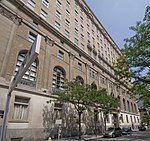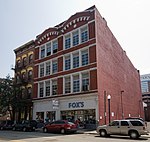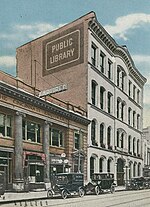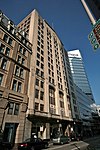The Old Main Library was a public library building in Cincinnati, Ohio, United States. Opened in 1870 and demolished in 1955, it served as the main library of the Cincinnati and Hamilton County Public Library (CHPL) system for 85 years.
In 1868, the Public Library of Cincinnati, then located in the Ohio Mechanics' Institute, purchased an opera house in construction after its owner went bankrupt. It hired architect James W. McLaughlin to convert the building, located on Vine Street at the corner of 6th Street, into a new library. Librarian William Frederick Poole significantly assisted McLaughlin with the design. Although construction of the Old Main had yet to be fully completed, a first portion opened on 9 December 1870. The rest was inaugurated in 1874. The main hall, whose cast-iron alcoves, spiral staircases and wide skylight garnered architectural praise.
Although it was often described as beautiful, the Old Main was considered congested and impractical. Its estimated capacity of 300,000 volumes was exceeded within two decades. In 1955, it had 1.5 million books, which had to be stacked three deep on bookshelves, or stored in basements, the attic or at other branches. This lead to various complications, including the difficulty of quickly producing requested books and the deterioration, from repeated flooding, of the volumes that were stored in the sub-basement. Other challenges included insufficient lighting, poor ventilation, lack of seating and elevator and fire safety. Because the building was heated by coal furnaces, dedicated "book cleaners" had to be hired to clean the soot off of the books and stacks.
Calls for a new library emerged in the 1920s and the project was officialized in 1944. A location for the "New Main" was found two blocks away from the Old Main, which closed its doors on 27 January 1955. It was demolished from March to June of that year. Because of its sturdiness, it was said to have "died hard", requiring 100 days of wrecking and a crew of 50 to 75 men. It was reportedly the largest demolition contract of Cincinnati's history at that time. Today, the site of the Old Main is occupied by an office building and a parking garage. Decades after the library's demolition, images of its interiors garnered significant public interest online.











